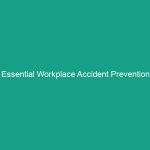Good Morning Team!
Today, we’re going to discuss an essential topic that impacts our Safety meetings and overall workplace dynamics: Essential Conflict Resolution in Safety Meetings: Handle Disagreements Effectively. It’s vital for us to address conflicts constructively to maintain a safe and productive Environment. Conflicts can arise in any team setting, and understanding how to manage them can lead to better collaboration, improved safety practices, and a healthier workplace culture.
Understanding Essential Conflict Resolution
So, what exactly do we mean by conflict resolution? In the context of our safety meetings, it refers to the methods and processes involved in facilitating the peaceful ending of a disagreement. Effective conflict resolution is crucial not just for maintaining harmony but also for ensuring that safety protocols are communicated effectively and adhered to by everyone.
When conflicts are left unresolved, they can lead to a toxic work environment, reduced morale, and ultimately, safety risks. It’s important to note that conflicts are not inherently negative; they can lead to constructive discussions if managed properly. However, one common misconception is that avoiding conflict is the best solution. In reality, addressing issues head-on is what fosters a culture of safety and respect.
Key Hazards, Risks, and Safety Considerations
Ignoring conflicts during safety meetings can pose serious risks, not just to interpersonal relationships but also to Workplace Safety. Here are some specific Hazards and risks associated with unresolved conflicts:
- Miscommunication: Disagreements can lead to misunderstandings about safety protocols, resulting in unsafe practices.
- Decreased Team Cohesion: Ongoing conflicts can fracture teamwork, making it harder to respond effectively in emergencies.
- Increased Stress Levels: Unresolved conflicts can lead to heightened stress, affecting employees’ focus and productivity.
- Potential Safety Violations: When team members are distracted by interpersonal issues, they may overlook critical Safety Measures.
For instance, consider a scenario where a disagreement about the proper use of safety equipment arises. If the conflict is not resolved, it could lead to employees neglecting proper Safety Gear, increasing the risk of accidents.
Best Practices, Procedures, & Actionable Advice
Let’s dive into some Best Practices for effective conflict resolution during our safety meetings:
1. Establish Ground Rules
Before diving into discussions, set clear ground rules for how disagreements will be handled. This could include:
- Respectful communication
- No interrupting
- Focus on the issue, not the person
2. Listen Actively
Active listening is crucial. Make sure that each team member feels heard. Use phrases like “I understand your point” or “Can you explain that further?” to show engagement.
3. Use “I” Statements
Encourage team members to use “I” statements rather than “you” statements. For example, instead of saying “You never follow safety protocols,” one could say, “I feel concerned when safety protocols aren’t followed.” This approach reduces defensiveness.
4. Focus on Solutions
Shift the focus from blame to solutions. Ask open-ended questions such as:
- “What can we do to prevent this situation in the future?”
- “How can we ensure everyone understands the safety protocols?”
5. Encourage Team Collaboration
Foster a collaborative environment where team members work together to find a resolution. This can be through brainstorming sessions or group discussions.
6. Document Conflicts and Resolutions
Keep a record of conflicts and their resolutions. This helps identify patterns and provides a reference for future discussions, ensuring continuous improvement.
7. Seek Mediation if Necessary
If a conflict escalates beyond what the team can manage, don’t hesitate to bring in a neutral third party to mediate the situation. This can help facilitate a fair resolution.
Regulations, Standards, and Compliance
In the realm of Workplace Safety, understanding Regulations is critical. Compliance with Standards set by organizations like OSHA and ISO ensures that we maintain a safe and efficient work environment. Here are a few relevant points:
- osha encourages open communication and conflict resolution as part of a comprehensive safety program.
- Company-specific policies may require documented conflict resolution processes to ensure accountability.
Compliance is not just about following rules; it’s about creating a culture of safety where everyone feels empowered to voice their concerns.
Employee Engagement & Discussion
Now that we’ve discussed conflict resolution, let’s open the floor for discussion. Here are some questions to consider:
- What safety challenges have you encountered related to conflicts in our meetings?
- How do you feel we can improve our approach to conflict resolution?
- Can you share an example where conflict resolution led to a positive outcome in our safety practices?
Conclusion & Key Takeaways
In conclusion, effective conflict resolution in safety meetings is crucial for maintaining a safe and productive workplace. By establishing ground rules, listening actively, and focusing on solutions, we can turn conflicts into opportunities for improvement.
Remember, the goal is not just to resolve conflicts but to foster an environment where safety is a shared responsibility. Thank you for your attention today, and let’s continue to prioritize safety in everything we do.


